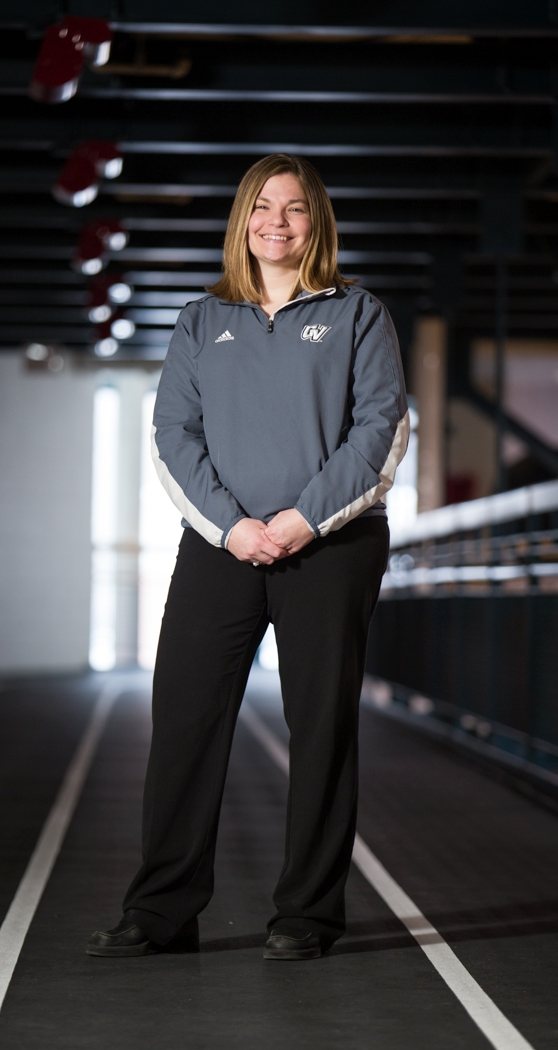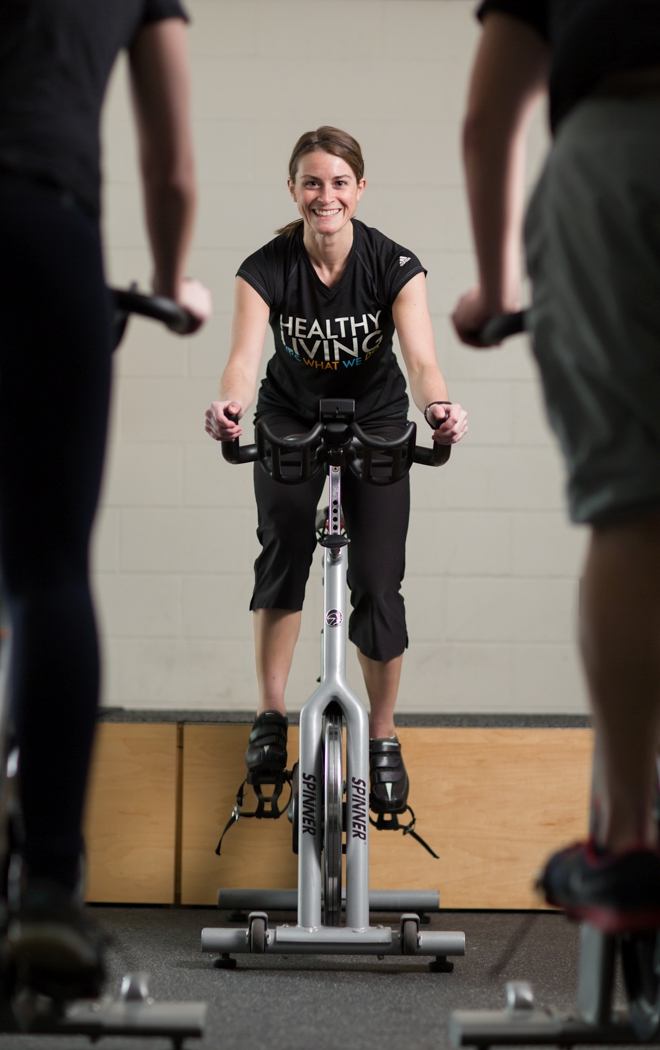Q&A Spring 2015
Harmon, DesArmo
photo by Amanda Pitts
Health and wellness programs and options for students, faculty and staff members at Grand Valley are expanding. The university offers more than a dozen programs for faculty and staff that promote healthy eating, physical activity and mental wellness. A variety of fitness classes, group activities, club sports and healthy meal choices are available for students.
The Recreation Center sees an average of 360,000 visits each year; there were 52,000 visits in January alone. The Board of Trustees approved a 16,900-square-foot addition to the center, scheduled to be completed in August 2016.
Grand Valley Magazine spoke with Kate Harmon, director of Campus Recreation, and Lindsey DesArmo, Health and Wellness specialist, about what it takes to create a fit campus.
GVM: The benefits of exercise and healthy eating are clear, but what has your research found about the benefits of incorporating health and wellness in the workplace or in an educational setting?
Harmon: Exercise helps with memory retention and is a stress reliever. Students feel a sense of belonging when they are involved in a sport or an activity. Many students participated in team sports in high school and look for that same opportunity in college. Our club sport opportunities fit that need, and that helps with retention.
DesArmo: Faculty and staff members who are physically healthy feel less stress, can manage their days better and feel more productive. It’s not about training for a marathon or performing amazing athletic feats. Physical health is about feeling well and being able to do our everyday activities. Some find it easier to commit to a healthier lifestyle when health and wellness are promoted in the workplace.
GVM: Do many participate in the available programs or visit the Recreation Center?
Harmon: We have more than a thousand students participating in club sports and last year 4,000 students participated in intramural sports. We are excited about the much-needed addition planned for the Rec Center. Last year, 17,000 students visited the Rec Center and there were 7,500 visits to
the Climbing Center. We’ve had students waiting in line to use certain rooms and equipment. The additional space will be used for more cardio equipment and room for weight lifting.

Kate Harmon
DesArmo: Participation in the Healthy Choices program (health screens for cholesterol, glucose, blood pressure, etc.) is just under 40 percent; that’s about 880 faculty and staff members out of 2,400 benefit-eligible employees. It expanded this year to include spouses and people in the household member program, so we are seeing increased participation. We had about 400 faculty and staff participate in the pedometer challenge this year, and participation has increased every year since we started.

Lindsey DesArmo
GVM: Are we a fit campus?
Harmon: I would say we have an engaged study body. The trends across the country in terms of student health are not good. We can always do better, and we want to eliminate barriers to exercise. Also, mental health issues and obesity continue to be concerns on campuses across the country. Students who exercise have a better outlook, better moods and a better well-being. It makes sense to have the Rec Center busy during exams.
DesArmo: Overall, Grand Valley is a healthy campus. We aren’t the healthiest; there is always room for improvement. Our biggest issues for faculty and staff are stress, high blood pressure, back pain and diabetes. When we look at our benchmarks we still have good numbers.
GVM: How does Grand Valley compare to other universities?
Harmon: We are more active than most campuses. Grand Valley has more than 55 club sports, which is far more than most peer institutions, and we have almost double the student participation of those institutions.
DesArmo: Grand Valley is on the forefront of employee wellness programs. While many colleges and universities have these programs in place, we excel in having a culture of health and wellness. People are now doing things on their own besides participating in set programs and challenges. We
provide support and resources, but people are engaging in their own way.
GVM: Are there any new trends or new ways to keep fit?
Harmon: Zumba continues to be popular with students and HIIT (high-intensity interval training) classes are also popular. Although not new, most students want to use cardiovascular equipment and do strength training with free weights.
DesArmo: Ergonomics is a new focus for us. Many employees are using standing desks and collaborative spaces, so relationships with Facilities Planning and Disability Support Resources are key to building an inclusive and healthy space. We also started a new initiative called Certified Healthy Departments, which means university departments can earn this status. The most popular programs continue to be group activities because of the accountability and relationships they build.
GVM: What are your goals?
Harmon: We are working on a marketing campaign to better educate students on the physical and mental benefits of exercise. We are also working with Housing on better ways to connect with first-year students.
DesArmo: We want to continue to build a culture of health and wellness on our campuses, and that culture is built through people. We want to create an environment where people can thrive, so I’m working on building those environments through policies and physical spaces that support healthy behaviors.
